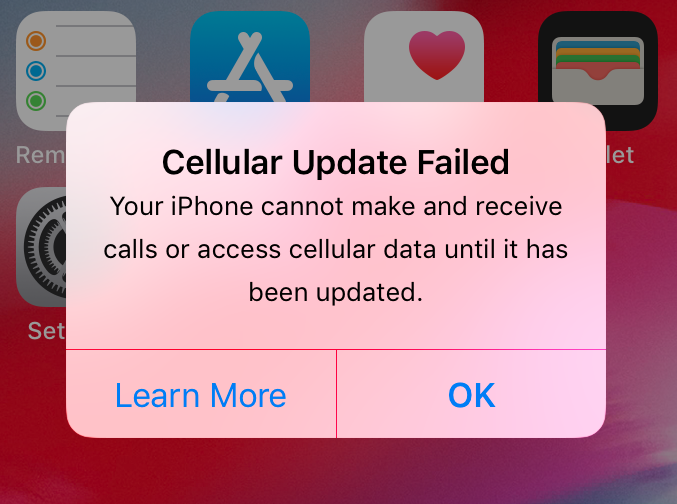
- #MAC PRO UPDATE FAILED MAC OS X#
- #MAC PRO UPDATE FAILED INSTALL#
- #MAC PRO UPDATE FAILED SOFTWARE#
- #MAC PRO UPDATE FAILED MAC#
Restarts automatically and goes through startup back to “Looking for applications…” Transfer of information begins, this time no problems. Process begins but while “Looking for applications and documents to transfer” the MacBook crashes. Selected Time Machine to reinstall files.
#MAC PRO UPDATE FAILED INSTALL#
Restarted MacBook, selected Install macOS. On a different computer downloaded fresh copy of High Sierra install and made a new bootable disc. Message “this copy of the insall application is damaged and can’t be used to install macOS’. Selected Disk Utility but it stalled at ‘loading disks’. Didn’t do this stage as already previously tried.Ĩ. Selected restart but MacBook again shut down during startup.ħ. From ‘view’ I selected ‘all devices’ and then ran first aid on the newly revealed hard disc item. I ran first aid but it immediately crashed. It asked me to select language (it hasn’t done this before) and then opened the menu. Successfully carried out Time Machine backup.ĥ.

I logged into my user (not admin) account. Reset SMC – again shut down during startupĤ. Zapping PRAM – more progress along the startup bar, but eventually went light grey and shut downģ. I then found advice at and ran through the various stages.Ģ. I reinstalled the OS but it still wouldn’t restart. I tried to start in safe mode but it wouldn’t. I created a USB bootable version of High Sierra and from that ran Disc Utility – but it showed no problems. The last line of the log file read “ADIGetIDMSRouting failed Error -45061” This week I was prompted to carry out a system security update (security update 2019-007 for 10.13.6) but afterwards it failed to restart (progressed to about one fifth of the way along the startup bar). When I upgraded from Sierra to High Sierra however I started having problems including failing at startup and random crashes of the whole system, the finder or various apps. It’s been fine, along with upgraded 1TB fusion disc, for years.
#MAC PRO UPDATE FAILED SOFTWARE#
Installation failures and software update failures should drive home the importance of always backing up a computer, particularly before installing any system software update, security update, or other software.Īfter macOS High Sierra 10.13.4 successfully installs, you can get a Security Update 2018-001 for macOS 10.13.4 as well, but don’t forget to backup before beginning that process either.ĭid these tricks work to resolve your problems installing macOS 10.13.4? Let us know in the comments below if these approaches worked for you, or if you found another solution.
#MAC PRO UPDATE FAILED MAC#
If all else fails, you can try restoring the Mac with a backup made from Time Machine to a date prior to installing 10.13.4, assuming you made one anyway (one of the many reasons regular backups are so important!).
#MAC PRO UPDATE FAILED MAC OS X#
Reinstalling Mac OS X through Recovery Mode is a tried and true troubleshooting approach for situations where the system software will not function as intended or won’t boot at all. Nonetheless it’s critical to have a backup of your data available just in case something goes haywire. Reinstalling macOS will just install a new copy of system software, it should not change any user files, applications, or data aside from system software.

Reboot the Mac and hold down Command + R keys to boot into Recovery Mode.If the Mac will not boot, you may need to reinstall Mac OS through Recovery Mode: If the Mac won’t boot as usual, try reinstalling Mac OS through Recovery Mode The Mac will reboot when updating has completed. Using combo updates to install Mac OS updates is pretty straight forward process, similar to running any other application installer. The Combo Update can be installed directly atop a prior macOS 10.13.x version. Click here to get the macOS 10.13.4 Combo Update package from Apple.If installation fails but the Mac is still usable as normal, try running the 10.13.4 Combo Update: If the Mac boots as usual, try the Combo Update Ideally you’d have made a backup before installing the system software update to begin with, which then allows you to roll back to that prior backup in the event neither of the following approaches work to resolve the problem. We’re going to focus on two main approaches running the update again (if it’s a general failure upon attempting to install from the App Store) or by trying to install macOS 10.13.4 with the macOS High Sierra 10.13.4 Combo Update package instead of through the Mac App Store, or simply choosing to reinstall macOS system software.īefore beginning any of these troubleshooting steps you should have a complete backup made of the Mac. If you have encountered an error or a failure when trying to update macOS 10.13.4 system software, you may be able to easily correct the problem by running through the troubleshooting steps detailed below.


 0 kommentar(er)
0 kommentar(er)
